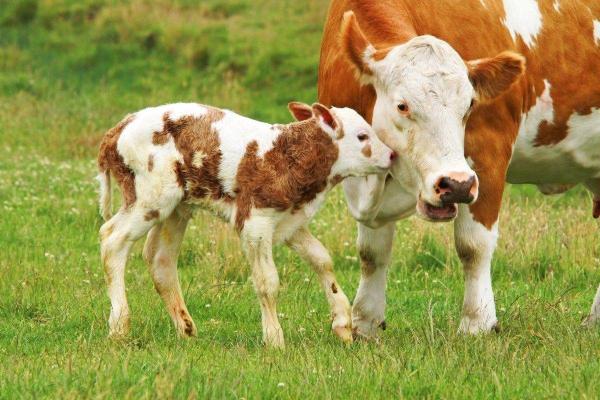
Brucellosis in cattle, also referred to as bovine brucellosis, is one of the most common diseases among cattle. This serious pathology is zoonosis, meaning it can be transmitted to humans and other animals. This disease of bacterial origin produces alterations within cattle reproduction, such as infallibility or miscarriages. Therefore, it is vital to take on the correct preventative measures to eradicate this pathology completely.
For more about the causes, symptoms, diagnosis and treatment of brucellosis in cattle, keep reading here at AnimalWised.
Brucella abortus
Bovine brucellosis, also known as Bang’s disease, is a bacterial disease caused by the bacterium Brucella abortus. The brucella abortus bacterium causes the contagious abortion of cattle and mainly affect heifers.
Due to the fact that this disease is zoonosis, it can have serious consequences on both cattle, humans and other animals. If you believe your cattle have contracted the Brucella abortus bacterium, immediate action needs to be taken in order for it not to spread.
Is brucellosis in cattle contagious to humans?
As we’ve already mentioned, there is a high risk of contagion to humans who come into contact with infected animals.
In humans, this infectious disease generates what is called undulant fever or Malta fever. Symptoms of Malta fever include:
- Headaches
- Irregular fever
- Chills
- Weight loss
- Heavy sweating
- Generalized pain
Brucellosis can be spread through unpasteurized milk or undercooked meat from an infected cow, and it causes severe infection in vital organs such as the liver or spleen. If you believe you’ve contracted brucellosis, make sure to contact a doctor as soon as possible.
Brucellosis in cattle: causes and transmission
The main route of bovine brucellosis contagion is through body fluids such as milk and/or water contaminated by feces. The two routes of bovine brucellosis transmission include:
- Vertical transmission: which occurs when the bacterium is transmitted to the offspring via the transplacental route or during breastfeeding. The consequences of this infection differ according to the gestation period in which it occurs.
- Horizontal transmission: occurs between sick animals and healthy animals. The routes of infection vary and could occur through air transfer, body secretions, placenta remains in the environment, contaminated water or food and/or through the skin.
Generally, bovine brucellosis is transmitted from an infected cow from one herd to another.
Brucellosis in cattle: symptoms
The most frequent brucellosis in cattle symptoms are those related to the reproductive system, the most striking and easily detectable is abortion (miscarriage), especially between the fifth and seventh month of pregnancy. Other symptoms of brucellosis include:
- Retention of the placenta
- Birth of weak or dead calves
- Vaginal discharge
- Sterility or reproductive difficulties
- Decrease in milk production
- Joint injuries
- Orchitis in the case of affected males
In many cases, at first sight, the newborn calves of affected mothers appear healthy. When difficult to detect, it will be necessary to perform serologic tests to be sure that the calf is healthy or, on the contrary, has contracted bovine brucellosis.
As long as a cow is a carrier, it can excrete pathogens by means of milk, as well as through feces and urine.

Brucellosis in cattle: treatment
In order to make an early diagnosis of bovine brucellosis, one needs to consider that retention of the placenta or abortions are usually a first indication. Serologic tests must be carried out in order to corroborate the presence of the infection.
Is brucellosis curable in cattle?
There is no treatment for brucellosis in cattle. If a cow is diagnosed positive for brucellosis, euthanization is recommended. This sacrifice is the only way in which this zoonosis bacterium can be completely eradicated. In order to avoid this unfortunate situation, it is essential to carry out the appropriate preventive measures.
Treatment of brucellosis in humans consists of a combination of antibiotic drugs prescribed for a duration of roughly 3 to 6 weeks. Although, recovery is usually positive, 10-15% of patients can present severe relapses.
Brucellosis in cattle: prevention
Due to the severe complications that this disease can cause, it is necessary to take the appropriate preventive measures. One of the most important ways of doing this is by controlling and managing your cattle. A minimum of one annual check of all cattle heads (of each flock) must be carried out. This check includes the performance of serologic tests, as well as an exhaustive milk analysis. If brucellosis is detected in an animal, this cow must be isolated immediately to prevent it from infecting others.
When herds are found in areas where there are brucellosis outbreaks or where brucellosis may be endemic, it is recommended that you vaccinate your cattle. There are different vaccines which can be prescribed, all of them made with a modified live virus. The brucellosis vaccine is known to be effective and will vary depending on a cattle’s geographical region.

This article is purely informative. AnimalWised does not have the authority to prescribe any veterinary treatment or create a diagnosis. We invite you to take your pet to the veterinarian if they are suffering from any condition or pain.
If you want to read similar articles to Brucellosis in Cattle - Causes, Symptoms and Treatment, we recommend you visit our Bacterial diseases category.
1 R.Fensterbank, Brucellosis in cattle, sheep and goats: diagnosis, control and vaccination. Rev. sci. tech. Off. int. Epiz., 1986, 5 (3), 605-618-